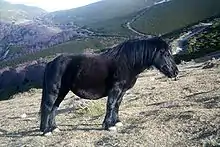Asturcón
The Asturcón is an ancient breed of small horse or pony from the autonomous region of Asturias in northern Spain. It has been documented since Roman times:[4] it has an unusual ambling gait, which was described by Pliny the Elder in his Naturalis Historia. It is of Celtic type, and shows similarity to the Pottok and Losino of Spain, the Garrano of Portugal, and the Dartmoor, Exmoor, Fell, Highland, Shetland and Welsh breeds of the British Isles.[3]:448
 | |
| Conservation status | FAO (2007): endangered-maintained[1]:108 |
|---|---|
| Other names | Asturian Pony |
| Country of origin | Spain |
| Distribution | Asturias, elsewhere in Spain |
| Traits | |
| Weight | |
| Height |
|
History
The Asturcón has been known and described since Roman times; it is mentioned in an epigram of Martial, and by Pliny the Elder in his Naturalis Historia, where he describes its characteristic ambling gait.[5][6][3]:448 The Latin word asturco was later used for other similar small horses with ambling gait.[5]
At about the time of the Spanish Civil War, the population of the Asturcón separated into two distinct parts, one in the sierras of Sueve and La Vita, and the other further to the west, in the sierras of El Palo, La Bobia and Tineo. The two populations are genetically distinct.[3]:449
A breeders' association, the Asociación de Criadores de Ponis de Raza Asturcón, was formed in 1987;[7] at the time there were 23 mares registered in the stud-book. At the end of 2003, there were 1181 head registered, in the hands of 94 breeders.[3]:449 In 2007 the Asturcón was listed by the FAO as "endangered-maintained".[1]:108
The Asturcón is thought to have given rise to the extinct Irish Hobby, and has been used in attempts to re-create that breed.[8]:440
Characteristics
The only coat colour admitted for registration in the stud-book is black; a small frontal star is allowed. There is a small population of bay Asturian horses of Celtic type, but they are not registered in the Asturcón stud-book.[3]:449
References
| Wikimedia Commons has media related to Asturcon. |
- Barbara Rischkowsky, D. Pilling (eds.) (2007). List of breeds documented in the Global Databank for Animal Genetic Resources, annex to The State of the World's Animal Genetic Resources for Food and Agriculture. Rome: Food and Agriculture Organization of the United Nations. ISBN 9789251057629. Accessed July 2014.
- Raza equino caballar Asturcón: Datos Morfológicos (in Spanish). Ministerio de Agricultura, Pesca y Alimentación. Accessed October 2018.
- Miguel Fernández Rodríguez, Mariano Gómez Fernández, Juan Vicente Delgado Bermejo, Silvia Adán Belmonte, Miguel Jiménez Cabras (eds.) (2009). Guía de campo de las razas autóctonas españolas (in Spanish). Madrid: Ministerio de Medio Ambiente y Medio Rural y Marino. ISBN 9788449109461. p. 438–41.
- Raza equino caballar Asturcón: Datos Generales (in Spanish). Ministerio de Agricultura, Pesca y Alimentación. Accessed October 2018.
- "Asturco", in: Charlton T. Lewis, Charles Short (1879). A Latin Dictionary. Founded on Andrews' edition of Freund's Latin dictionary. Oxford: Clarendon Press.
- "Pliny the Elder, Karl Friedrich Theodor Mayhoff (editor) (1906). Naturalis Historia. Lipsiae: Teubner.
- La Asociación (in Spanish). Asociación de Criadores de Ponis de Raza Asturcón. Accessed October 2018.
- Valerie Porter, Lawrence Alderson, Stephen J.G. Hall, D. Phillip Sponenberg (2016). Mason's World Encyclopedia of Livestock Breeds and Breeding (sixth edition). Wallingford: CABI. ISBN 9781780647944.